Sunday, March 13
8:23 p.m.
I have a biological clock for ferments, and in the icy pre-spring, tempeh is always on my mind. Tempeh, which originated in Indonesia, where it is fermented in tropical heat between banana leaves, is essentially a mushroom that grows on beans—the fungi Rhizopus oryzæ prefers growing on soy, but really it will do fine on most legumes and even on seeds.
I always recommend tempeh as a gateway mold for the fermentation-curious, for a few reasons. First, it requires very little overhead—just a pound of organic soybeans, tempeh starter (which is easily ordered on Cultures for Health), a thermometer, a ziplock bag, and a little vinegar. And, it’s relatively quick. Unlike kombucha, which takes two weeks, or miso, which can take months, tempeh fermentation only takes about 48 hours—a day and a half—to complete. Compared to the packaged pre-cooked tempeh you can buy at the grocery store, homemade tempeh is nutty and rich, with a medium-rare chew. Crisped up with coconut oil, it’s enough to make anyone a believer.
I like fermentation projects because of the easy narrative. Inside of your enormous chaotic life, a little three-day loop to worry over, to marvel at, to invent within—like a bottle episode of a television show, or like a time capsule. I’ve been noticing the light changing in Brooklyn lately, getting longer and warming, though I’m still in wool socks every day. It’s been a long weekend, but before I get ready for bed, I pour a pound of organic soybeans and water into a glass jar to soak overnight.
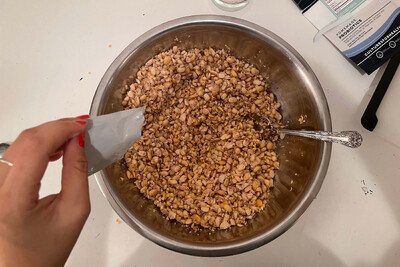
photos courtesy of Wei Tchou
Monday, March 14
8:03 a.m.
I wake up begrudgingly to my alarm and trudge into the kitchen to pour the fully soaked soybeans into my Dutch oven. They’ll simmer on low heat until tender. As I get back into bed, I sleepily assess the Monday meetings and tasks that I have to accomplish for the day and, in my head, arrange them around my fermentation schedule.
9:24 a.m.
I wake up again to the smell of steaming soybeans, which is so distinct and wonderful—sweet and earthy, like simmering corn. I lie in bed for a long time once I’m awake, drinking a cup of coffee and enjoying the redolent soy fog. I reflect on all my previous tempeh springs, some successful, some disastrous. It’s nice to remember again who I was with, where I was living, what life was like then.
11:50 a.m.
The beans are tender, so I use a big wooden spoon to press them against the side of the Dutch oven to squeeze them out of their skins. This is the most laborious step of the process, but it’s necessary, as the Rhizopus oryzæ spores won’t be able to inoculate the beans and develop mycelium—the network of branching, fine white threads of fungi—if their hulls are still intact. When the water cools enough, I plunge my hands in and start rolling whole beans in my fingertips one by one, to pop them from their skins.
I’m always thinking of death these days, during stultifyingly rote tasks, such as this. There are the obvious reasons for the intrusive idea—war in Ukraine, the novel coronavirus, our collective environmental grief, my rapidly approaching mid-30s. Then there are reasons that lurk too deeply within my unconsciousness to address or even come to know. I observe them only in my hapless desperation to do something, to be outside of myself: go vegetarian, cut plastic, buy property in Vermont. I return to myself in quiet, long moments … kneading bread or scrubbing my range or slowly combing over soybeans. Oh, here I am again, I think, as time moves again moment-to-moment. What to make of the fact of warm water on my hands, the tinniness of the splashing, my slight headache … of the difference between now and tomorrow?
The furthest I’m ever able to get is knowing that, despite everything, I am fulfilled by the cornflower scent of steaming soybeans, by observing my own fussiness in picking off their jackets one by one. I’ve resigned myself lately to choosing the pleasure and intensity of what is in front of me.
It’s fine if a few of the soybeans don’t slough off their skins, you only need about 80% accuracy here. It’s also fine if the beans wind up in pieces—the spores don’t care about aesthetics, just access to protein. Once the beans are fully hulled, I drain and spread them out on two paper towel-lined sheet trays to dry out and come to room temperature.
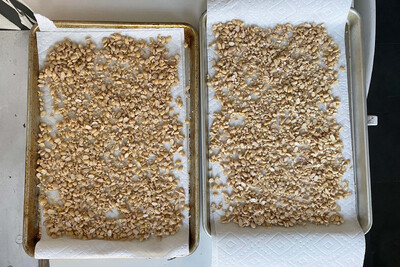
7:52 p.m.
The beans are finally dry to the touch so I sit down to poke holes in the ziplock bag that will pack the beans loosely together as the Rhizopus oryzæ mycelium grows around them, binding them into a cake. It’s extremely important to make enough holes in the ziplock and to make them big enough for good aeration—unlike other ferments, tempeh prefers to be dry and won’t grow well if there’s a great deal of humidity in the bag.
As with all ferments, regulating temperature and moisture during the tempeh making is terribly important. Tempeh grows best between 85 and 90 degrees Fahrenheit, for about 48 hours. Grow it too hot and it’ll go to spore before the tempeh is fully developed. Grow it too slow, and you run the risk of other bacteria or bad molds competing with Rhizopus oryzæ, and possibly overtaking it.
I mix together the soybeans, the tempeh starter, a tablespoon of vinegar (raising the pH level of the beans helps to fight off contaminants), and a half cup of roasted sesame seeds in a mixing bowl, then gingerly fill the perforated ziplock and seal it shut.
8:50 p.m.
I place the bag on a baking sheet, on a rack, in the oven, with the oven light on. I spike an internal thermometer into the side of the bag and perch an external thermometer on the rim of the pan. We’re at 95 degrees right now, anticipating the nighttime chill to push it at least five degrees cooler.
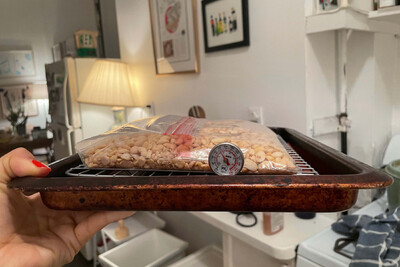
Tuesday, March 15
11:30 a.m.
Eventually, the cake will start to produce its own heat, and it will be less important to monitor it so consistently, but for now, I check on it frequently, watching the degrees tick up and down. We’re still hours away from seeing any mycelium, and life goes on now, parallel to the tempeh—a partner you trust to be on their own journey. I like this part the best.
A good friend of mine had her eggs frozen recently, and she told me that the best part was having an excuse to be home by seven every night, so she could give herself the fertility injections. The idea resonates with me as I structure my days to properly monitor the tempeh. I am more decisive than usual about what I will and won’t do. You can’t really afford to bend to anyone else’s schedule when the price of distraction, of staying out longer than you wanted with your friends, might be the difference between an ethereal loaf of mushroom and an inedible ammonia-drenched mess.
I feel a little sad, too, reflecting on the need to invent an excuse in order to be on my own schedule, to tack purely by desire.
4:08 p.m.
Days like this seem to go up in smoke, there are so many things to keep track of. But in between completing arduous checklist items and generating new checklist items, I wander over to the oven and check the tempeh. I’m seeing little blooms of white against the plastic of the bag—signs of life. It feels like taking a deep breath, sinking for a moment into this secret universe during the swirling mayhem of my workday.
5:30 p.m.
All at once, it seems, a miniature blizzard lights across the top of the soybeans. It never gets old, watching a ferment take off on its own. The cake is generating its own heat, so I can be a little more hands-off for the next few hours, though I still have to monitor it fairly frequently, now, to make sure I don’t overshoot. Good to moderate growth at this point, so I turn the oven light off to cool things down.
9:28 p.m.
It’s bedtime for me. The tempeh seems to be moving slowly but steadily.
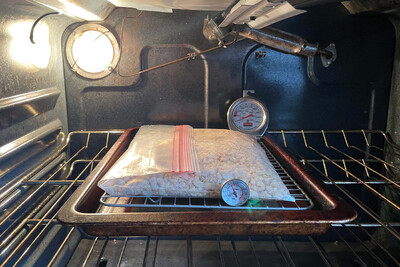
Wednesday, March 16
7:05 a.m.
Fuzzy gray patches have appeared on the surface of the tempeh overnight, though the tempeh is still a little bare. Shit, I think, panicking at the discoloration—well-developed tempeh should instead resemble a cumulus cloud. I check the temperature and see that the oven is running around 100 degrees—a sign that I’ve let the ferment run too hot, causing the tempeh to grow too fast. I feel cranky and disappointed that it’s not more beautiful, but generally speaking, such coloring on tempeh is safe to eat, so it’s fine.
I trim off the ends that have gone black, fully to spore (it’s fine to eat these, but they tend to taste a little ashy), throw the tempeh in the fridge and get back in bed.
7:45 a.m.
I lie awake feeling a little forlorn about the gray tempeh, retreading my steps and feeling annoyed that I screwed it up. But eventually, a plush thought emerges—maybe these feelings are also part of the pleasure of it all: Things go wrong, we don’t always get what we want. Agreeing to participate inevitably means accepting what’s out of our control. I’m drawing a line to my greater despair now and thinking: We’re always getting older, there’s always been war, there’s always been suffering, there’s always another enormous wave threatening the livelihoods of the Taiwanese. And I don’t know, man, people have also always made tempeh, people have always found small, beautiful ways to keep living. I drift asleep building an enormous coconut oil-fried tempeh sandwich in my head … lots of sprouts, avocado, and mayonnaise.
Recipe links
Sesame tempeh
Tempeh sandwich with sprouts and avocado
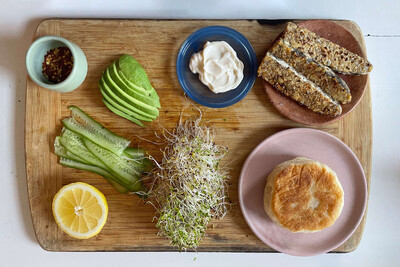

Wei Tchou
Wei writes about culture, food, and nature. She lives in Brooklyn.
Prism asks: What is the most unique thing you’ve ever eaten?
“While I was reading The Omnivore’s Dilemma as an impressionable teenager, and clumsily rethinking my relationship to eating animals, I took a trip to the Ecuadorian Amazon. During a particularly arduous hike, my rainforest guide pulled up a long blade of grass, on which were a dozen or so small ants. He motioned for me to eat them, so I did. They tasted exactly like lemons. I would say this sums up my approach to plant-based eating—make good, righteous decisions about what you’re eating, when you can. But always eat the ants!”

Wellness stories you won’t find anywhere else.

